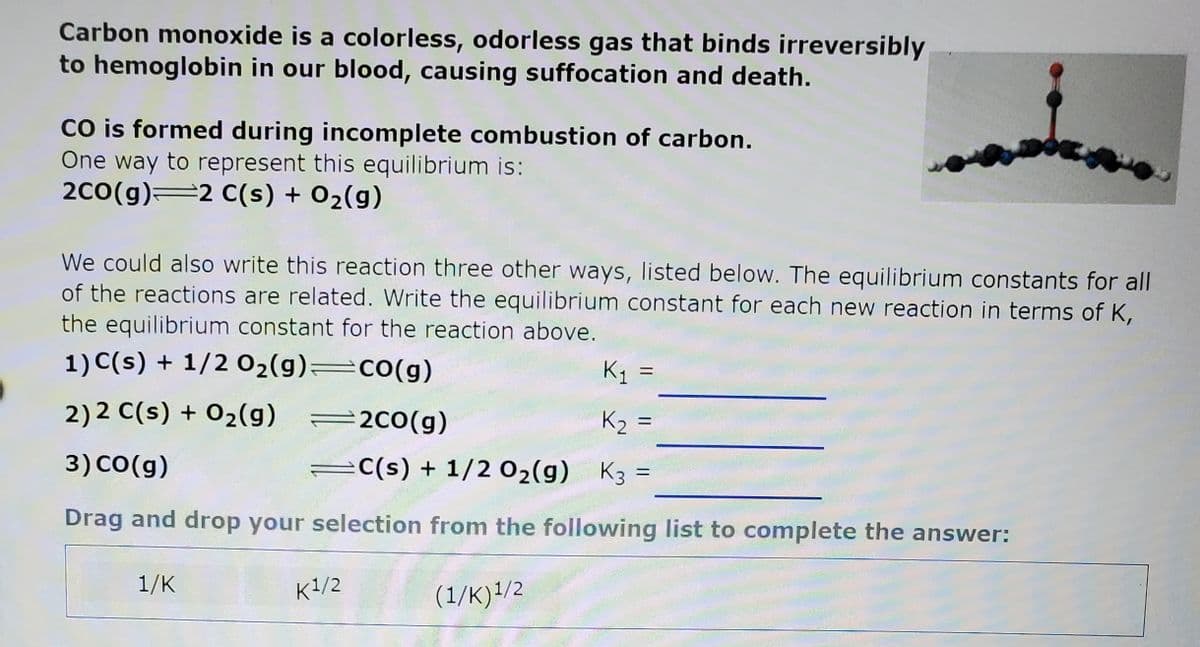Carbon monoxide is a colorless, odorless gas that binds irreversibly to hemoglobin in our blood, causing suffocation and death. co is formed during incomplete combustion of carbon. One way to represent this equilibrium is: 2c0(g) 2 C(s) + 02(g) We could also write this reaction three other ways, listed below. The equilibrium constants for all of the reactions are related. Write the equilibrium constant for each new reaction in terms of K, the equilibrium constant for the reaction above. 1) C(s) + 1/2 02(g) co(g) K1 = 2)2 C(s) + 02(g) =2c0(g) K2 = 3) CO(g) =C(s) + 1/2 02(g) K3 = Drag and drop your selection from the following list to complete the answer: 1/K K1/2 (1/K)!/2
Carbon monoxide is a colorless, odorless gas that binds irreversibly to hemoglobin in our blood, causing suffocation and death. co is formed during incomplete combustion of carbon. One way to represent this equilibrium is: 2c0(g) 2 C(s) + 02(g) We could also write this reaction three other ways, listed below. The equilibrium constants for all of the reactions are related. Write the equilibrium constant for each new reaction in terms of K, the equilibrium constant for the reaction above. 1) C(s) + 1/2 02(g) co(g) K1 = 2)2 C(s) + 02(g) =2c0(g) K2 = 3) CO(g) =C(s) + 1/2 02(g) K3 = Drag and drop your selection from the following list to complete the answer: 1/K K1/2 (1/K)!/2
Chemistry: The Molecular Science
5th Edition
ISBN:9781285199047
Author:John W. Moore, Conrad L. Stanitski
Publisher:John W. Moore, Conrad L. Stanitski
Chapter12: Chemical Equilibrium
Section: Chapter Questions
Problem 61QRT
Related questions
Question
100%

Transcribed Image Text:Carbon monoxide is a colorless, odorless gas that binds irreversibly
to hemoglobin in our blood, causing suffocation and death.
Co is formed during incomplete combustion of carbon.
One way to represent this equilibrium is:
2c0(g)=2 C(s) + 02(g)
We could also write this reaction three other ways, listed below. The equilibrium constants for all
of the reactions are related. Write the equilibrium constant for each new reaction in terms of K,
the equilibrium constant for the reaction above.
1) C(s) + 1/2 02(g)=co(g)
K =
2) 2 C(s) + 02(g)
=2c0(g)
K2 =
%3D
3) CO(g)
C(s) + 1/2 02(g)
K3 =
Drag and drop your selection from the following list to complete the answer:
1/K
K1/2
(1/K)1/2
Expert Solution
Step 1
The equilibrium constant of a reaction is the ratio between the product's concentration to the concentration of reactants. Each term will have a power equal to the respective stoichiometry of the compound present in the reaction.
Trending now
This is a popular solution!
Step by step
Solved in 4 steps

Knowledge Booster
Learn more about
Need a deep-dive on the concept behind this application? Look no further. Learn more about this topic, chemistry and related others by exploring similar questions and additional content below.Recommended textbooks for you

Chemistry: The Molecular Science
Chemistry
ISBN:
9781285199047
Author:
John W. Moore, Conrad L. Stanitski
Publisher:
Cengage Learning

Introduction to General, Organic and Biochemistry
Chemistry
ISBN:
9781285869759
Author:
Frederick A. Bettelheim, William H. Brown, Mary K. Campbell, Shawn O. Farrell, Omar Torres
Publisher:
Cengage Learning

Chemistry & Chemical Reactivity
Chemistry
ISBN:
9781133949640
Author:
John C. Kotz, Paul M. Treichel, John Townsend, David Treichel
Publisher:
Cengage Learning

Chemistry: The Molecular Science
Chemistry
ISBN:
9781285199047
Author:
John W. Moore, Conrad L. Stanitski
Publisher:
Cengage Learning

Introduction to General, Organic and Biochemistry
Chemistry
ISBN:
9781285869759
Author:
Frederick A. Bettelheim, William H. Brown, Mary K. Campbell, Shawn O. Farrell, Omar Torres
Publisher:
Cengage Learning

Chemistry & Chemical Reactivity
Chemistry
ISBN:
9781133949640
Author:
John C. Kotz, Paul M. Treichel, John Townsend, David Treichel
Publisher:
Cengage Learning

Chemistry & Chemical Reactivity
Chemistry
ISBN:
9781337399074
Author:
John C. Kotz, Paul M. Treichel, John Townsend, David Treichel
Publisher:
Cengage Learning

Introductory Chemistry: A Foundation
Chemistry
ISBN:
9781285199030
Author:
Steven S. Zumdahl, Donald J. DeCoste
Publisher:
Cengage Learning

Chemistry for Engineering Students
Chemistry
ISBN:
9781337398909
Author:
Lawrence S. Brown, Tom Holme
Publisher:
Cengage Learning